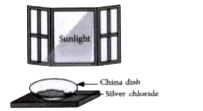Observe the given figure and identify the correct statements.

(i) Magnesium ribbon burns in air with a dazzling white flame.
(ii) It is a displacement reaction.
(iii) Magnesium oxide is basic in nature and turns most red litmus paper blue.
(iv) It is an exothermic reaction.
(i) and (iii)
(ii) and (iv)
(i), (iii) and (iv)
(i) and (iv)
The correct Answer is:C
It is a combination reaction.
Topper's Solved these Questions
- BOOK - MTG IIT JEE FOUNDATIONCHAPTER - FOOTSTEPS TOWARDS (JEE MAIN) EXERCISE - Integer/Numerical Value Type5videos
FOOTSTEPS TOWARDS (JEE MAIN)
- BOOK - MTG IIT JEE FOUNDATIONCHAPTER - FOOTSTEPS TOWARDS (NEET) EXERCISE - MCQ45videos
FOOTSTEPS TOWARDS (NEET)
- BOOK - MTG IIT JEE FOUNDATIONCHAPTER - FOOTSTEPS TOWARDS CBSE BOARDEXERCISE - SECTION - C39videos
FOOTSTEPS TOWARDS CBSE BOARD
Similar Questions
What is a redox reaction? When a magnesium ribbon burns in air with a dazzling flame and forms a white ash, is magnesium oxidised or reduced? Why?
View SolutionMagnesium ribbon burns with a dazzling flame in air (or oxygen) and changes to white substance magnesium oxide. Is magnesium being oxidised or reduced in this reaction ?
View Solution
Knowledge Check
- Question 1 - Select One
Observe the given figure and answer the question that follows:

State True (T) or False (F) for the following statements.
(i) It is a photodecomposition reaction.
(ii) Silver chloride turns grey in sunlight to form silver metal.
(iii) It is an exothermic reaction.
(iv) Silver bromide also behaves in the same way and used in black and white photography.A(i)(ii)(iii)(iv)TTTTB(i)(ii)(iii)(iv)TFTFC(i)(ii)(iii)(iv)TFFTD(i)(ii)(iii)(iv)TTFT - Question 2 - Select One
Assertion : A magnesium ribbon burns with a dazzling flame in air and changes into a white substance, magnesium oxide.
Reason : It is an example of decomposition reaction.AIf both assertion and reason are true and reason is the correct explanation of assertion.BIf both assertion and reason are true but reason is not the correct explanation of assertion.CIf assertion is true but reason is false.DIf both assertion and reason are false. - Question 3 - Select One
Select the correct statement :
(I) Metal oxides are basic in nature
(II) Metal oxides are acidic in nature
(III) Metal oxides react with acid to form salt and water
(IV) Metal oxides react with base to form salt and waterABoth (I) and (III)BBoth (I) and (IV)CBoth (II) and (III)DBoth (II) and (IV)
A combines with B to form C and D. A and D are major contributors to global warming and both are carbon compounds. B is a supporter of combustion. Magnesium burns in the presence of B with a dazzling white flame and forms a product X which is basic in nature. With C, X forms a compound which turns red litmus paper blue. Give the respective chemical reactions involved.
View SolutionA combines with B to form C and D. A and D are major contributors for global warming and both are carbon compounds. B is a supporter of combustion. Magnesium burns in the presence of B with a dazzling white flame and forms a product X which is basic in nature. With C, X forms a corresponding compound which turns red litmus paper to blue. Give the respective chemical reaction involved.
View SolutionFrom the options given along the side of each statement, select the most appropriate.
(i) A metal that gets covered with a protective film of its oxide : Al, Cu, Ag
(ii) A metal which burns in air will golden flame : Zn, K, Na
(iii) A metal which can displace hydrogen from boiling water as well as steam : K, Zn, Fe
(iv) A metal that does not react with air at room temperature. : Na, Mg, CaView SolutionA student burns a magnesium ribbon in air and dissolves the ash of the ribbon left after burning in distilled water. On pouring one drop each of this solution, first in blue litmus and then in red litmus solution, he would observe that
View SolutionA student burns a magnesium ribbon in air and dissolves the ash of the ribbon left after burning in distilled water. On pouring one drop each of this solution, first in blue litmus and then in red litmus solution, he would observe that
View Solution
